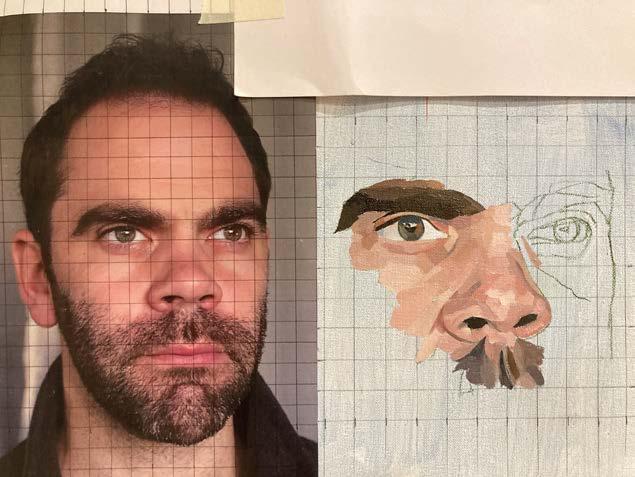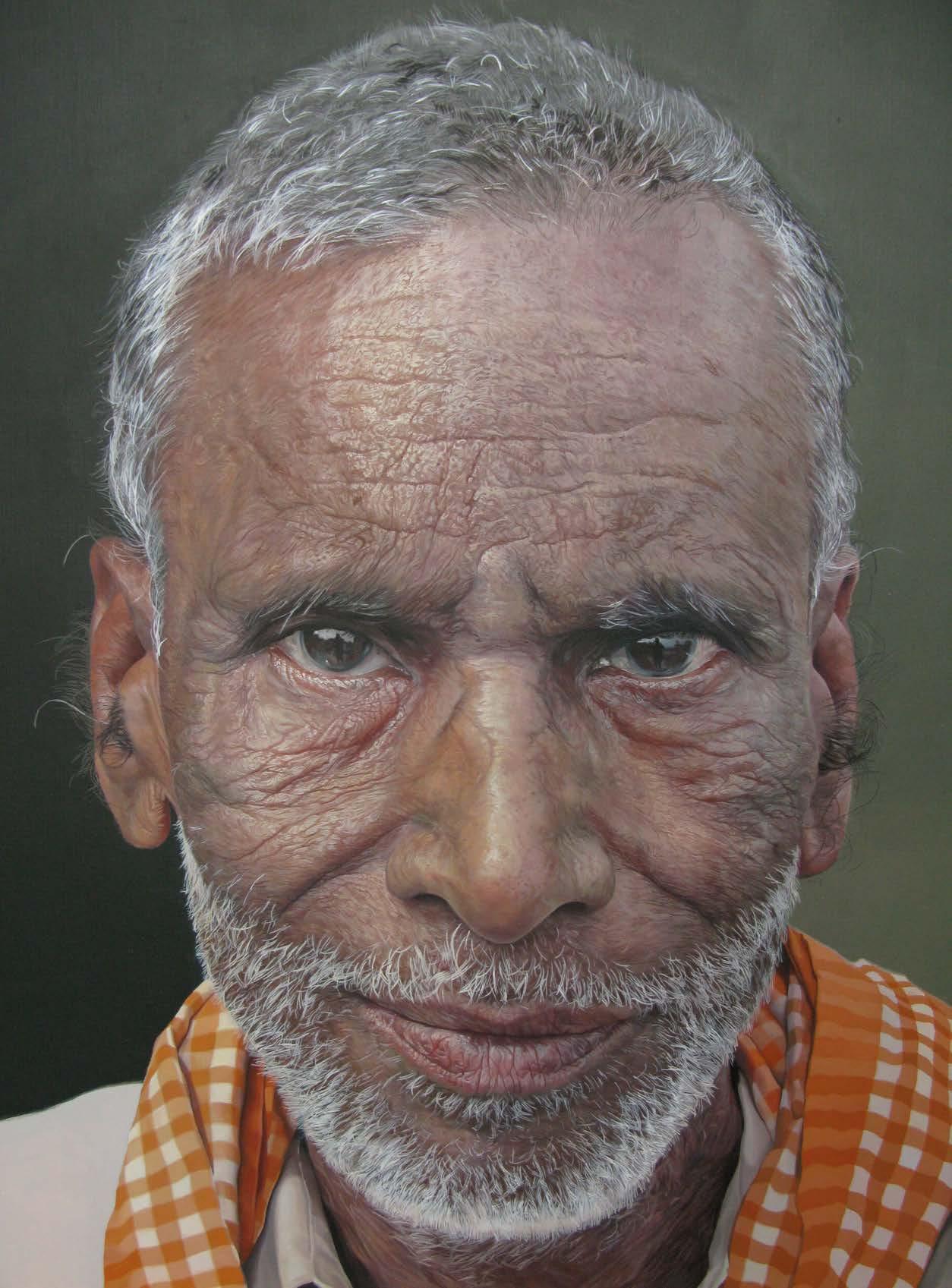
7 minute read
Project
PROJECT
Painting FROM PHOTOS
Former BP Travel Award winner EDWARD SUTCLIFFE shares his simple seven-step plan for making striking realist paintings from your source pictures
RIGHT Nora, oil on canvas, 170x110cm
Whether you are a beginner or have been interested in art for a period of time, below are seven principles, skills and philosophies that, if followed, will make you a more accomplished realist painter.
I guess there’s only one caveat here: that the responsibility for putting these principles into practice is down to you. There is no “silver bullet” when it comes to painting; it will make demands of you and you will find it difficult. However, if you enjoy the act and if you put in the hours over a period of time, then there is nothing stopping you creating wonderful art. While this piece has been written from the perspective of painting from photographs, many of the principles can be equally applied to working directly from life.
1. STATE YOUR INTENT
At the beginning of each painting, write down a very short statement of intent: one or two sentences about what you want your artwork to say and do. This will give you clarity and help you to avoid the creative cul-de-sacs that many painters find themselves drawn down.
Think about how you want to work. Most paintings, regardless of their originality, are in some way attached to a genre or style. Do you want to be a photorealist? An impressionist? An expressionist or work in a traditional academic style?
It’s also worth thinking hard about how your painting will be interesting and engaging to other people when they see it. Good art is packed with emotion; it tells honest stories from the artist’s own experience. People will want to see your story, your observations and your experiences interpreted in paint, so write them down first to give you a focal point when creating.
2. LEARN HOW TO LOOK
Your eyes are your biggest asset when painting. Just as a chef must cultivate an ability to taste and a musician to listen, a painter must learn how to look. Start with some exercises. The next time you are out in your garden or go for a walk, take a close look at the trees. Notice the textures and subtle greens that exist within the bark and think for a moment about how this would translate to paint.
The act of looking is in many ways the most crucial aspect of any realist painting. Before you even get to looking at the photo, your subject matter should be burned on the back of your retina! The more you have looked at your chosen subject, the easier it will be for you to translate it into paint. If you make a habit of looking in this way, the effort will be repaid. And if you are always on the lookout for interesting things in everyday life, you will often find the inspiration for your next painting hiding in plain sight too.
Creating paintings from photos can make the practice of looking easier. Colours and tones are locked into the image; they will always be consistent and won’t change. This makes the job of finding them and mixing them precisely on your palette an achievable skill. 3. USE GOOD TONES
Painting from photographs requires a good source image. Try to take or choose a photo that has a clearly defined tonal structure – in other words, one made up of distinct areas of light, mid- and dark tones.
Using a photo of a well-lit subject with a clear tonal structure does a lot of the work for you and actually makes it easier to translate the subject into paint. You are also able to edit the image by adjusting the contrast, exposure, saturation and so on.
If you are working from a photo, or even from life, and you are struggling to see the full tonal structure, get yourself a sheet of green or red acetate and hold it in front of your source. Blocking out the full spectrum will help reveal the range of tones.
4. MAP OUT SHAPES
Before starting a painting, you are usually confronted by a white canvas or sheet of paper. However, white isn’t always the ideal surface to work on because it is too bright. If not dealt with properly, it can make the colours and tones of the resulting painting lack richness and depth.
It’s always best to “kill” a white surface with a thin wash of neutral paint (either acrylic or oil, though the former dries quicker). This needn’t be too dark or thickly applied, just enough to ensure you are not painting on brilliant white. Then it’s time to start drawing.
The choice of drawing tool isn’t a concern – it’s what you draw, not what you draw with that’s important. Any realistic painting is made up of a patchwork pattern of colours and
RIGHT Gridding up your reference photo and canvas can help you see things accurately your drawing should aim to delineate the edges or contours of this patchwork. Forget details for now and try to construct a map that you will later fill with colour. Remember to look hard and search for those shapes.
Sometimes a grid can help with accuracy. Draw a simple grid on your photo and do the same on your canvas or paper, varying it according to scale. The shapes and contours of a subject are easier to see accurately with grid lines to judge against.
OPPOSITE PAGE On Assi Ghat, oil on canvas, 55x40cm 5. COLOUR A PATCHWORK
Now you need to fill your patchwork pattern with paint and for me this is where the fun starts. Locate a colour from your source, mix that colour in paint, and put it down on your canvas in the correct place. I say “put down” because it’s best to avoid any mixing or blending of paint on the canvas; if you do this, your painting can become a muddy mess and will lack definition. Mix colours on your palette instead.
Having the ability to mix any colour you see is simple, but it will take time to master. Avoid having too many pigments on your palette. I’ll usually have Titanium White, Cadmium Yellow, Yellow Ochre, Cadmium Red, Alizarin Crimson, Burnt Sienna, Burnt Umber, French Ultramarine and Ivory Black.
Mixing colours can be a challenge, which is why working from photos can simplify matters. Having the image and the painting next to each other and within your field of vision will enable you to get a quick measure on the accuracy of your colours.
Try this approach out. Locate a specific colour in your photo and make a rough mix of it. Now look hard at it and ask yourself questions. Is it too light? Add yellow or white. Is it too dark? Adjust with blue, black or earth colours, perhaps. Now stop again and look at what you have made. Should it be more yellow, red or blue? Add the required paint.
Now loop around and repeat the whole process again, first changing the tone (the relative lightness or darkness) and then changing the hue. Keep looking and continue with this looping process until you have a colour match. If you repeat and practice this loop of assessments and adjustments, you’ll eventually be able to mix and put down any colour. 6. GLAZE FOR DETAIL


Try to get as good and as convincing a likeness as you can with your initial painting. However, it is possible to create more detail and richer colours through a technique known as glazing [see Issue 429].
If, like me, you’re using oil paint, the glazing stage is when you should start adding linseed oil to the mix. This makes the paint more translucent and gives it a rich gloss. (If you’re using acrylic paint, add acrylic medium and water instead of linseed oil.)
Before beginning to glaze, allow your painting to fully dry. Look hard at your photo then turn to your painting. Search for the details and nuances in the photo that you can’t see in your painting. Once found, start adding them into your painting as thin glazes. It takes time to master but persevere – glazing gives paintings a rich lustre.
7. ENJOY THE PROCESS
I love working from photos as I never really have to worry about light conditions or models not turning up. That in turn allows me to lose myself in the act of painting. It’s important to stress that you must find a process that you enjoy. This enjoyment will act as a fuel to power you to improvement. Find a way of working that you enjoy and keep going. Feel free to take out and add things to the methods that I have written about. It’s important that you make paintings that give you a sense of excitement and anticipation. That will breed confidence and help your work engross other people too. www.edwardsutcliffeart.com











